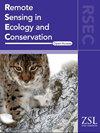Remotely sensing coral bleaching in the Red Sea
IF 4.3
2区 环境科学与生态学
Q1 ECOLOGY
引用次数: 0
Abstract
Coral bleaching, often triggered by oceanic warming, has a devastating impact on coral reef systems, resulting in substantial alterations to biodiversity and ecosystem services. For conservation management, an effective technique is needed to not only detect and monitor coral bleaching events but also to predict their severity levels. By combining high‐resolution satellite measurements (Sentinel‐2 Multispectral Instrument) and a bottom reflectance model within a least‐squares approach, we developed a new ocean color remote‐sensing model specifically designed to detect, map, and predict severity levels (low to high) of coral bleaching events at a high spatial resolution of 10 m. The proposed algorithm was implemented and tested within the Red Sea and compared remarkably well with concurrent and independent in situ data. We also applied the algorithm to investigate the response of corals during and after a bleaching event in the Wadi El‐Gemal region (Egypt) from July to December 2020. Our results show that coral bleaching severity levels and sea surface temperature (SST) were unusually high during August–September 2020. After the event, the coral bleaching signal decreased concurrently with SST during October–November 2020, aligned with a recovery of bleached coral reefs by December 2020. The proposed algorithm offers a cost‐effective approach toward developing a near‐real‐time remote‐sensing system for monitoring coral bleaching events and recovery at multi‐reef scales. Such remote‐sensing tools would aid policymakers and managers in developing and implementing integrated management strategies for coral reef conservation, as well as in supporting reactive management plans, including the identification of priority areas for intervention.遥感红海珊瑚白化
通常由海洋变暖引发的珊瑚白化对珊瑚礁系统造成毁灭性影响,导致生物多样性和生态系统服务发生重大变化。在保育管理方面,不仅需要一种有效的技术来检测和监测珊瑚白化事件,而且还需要一种有效的技术来预测其严重程度。通过结合高分辨率卫星测量(Sentinel - 2多光谱仪器)和最小二乘方法中的底部反射率模型,我们开发了一种新的海洋颜色遥感模型,专门用于在10米的高空间分辨率下检测、绘制和预测珊瑚白化事件的严重程度(从低到高)。提出的算法在红海进行了实施和测试,并与并发和独立的原位数据进行了非常好的比较。我们还应用该算法研究了2020年7月至12月埃及Wadi El - Gemal地区白化事件期间和之后珊瑚的反应。我们的研究结果表明,2020年8月至9月期间,珊瑚白化严重程度和海面温度(SST)异常高。事件发生后,2020年10月至11月期间,珊瑚白化信号与海温同时下降,与2020年12月白化珊瑚礁的恢复一致。所提出的算法为开发近实时遥感系统提供了一种经济有效的方法,用于监测多珊瑚礁尺度上的珊瑚白化事件和恢复。这种遥感工具将有助于决策者和管理者制定和实施珊瑚礁保护的综合管理战略,以及支持反应性管理计划,包括确定优先干预领域。
本文章由计算机程序翻译,如有差异,请以英文原文为准。
求助全文
约1分钟内获得全文
求助全文
来源期刊

Remote Sensing in Ecology and Conservation
Earth and Planetary Sciences-Computers in Earth Sciences
CiteScore
9.80
自引率
5.50%
发文量
69
审稿时长
18 weeks
期刊介绍:
emote Sensing in Ecology and Conservation provides a forum for rapid, peer-reviewed publication of novel, multidisciplinary research at the interface between remote sensing science and ecology and conservation. The journal prioritizes findings that advance the scientific basis of ecology and conservation, promoting the development of remote-sensing based methods relevant to the management of land use and biological systems at all levels, from populations and species to ecosystems and biomes. The journal defines remote sensing in its broadest sense, including data acquisition by hand-held and fixed ground-based sensors, such as camera traps and acoustic recorders, and sensors on airplanes and satellites. The intended journal’s audience includes ecologists, conservation scientists, policy makers, managers of terrestrial and aquatic systems, remote sensing scientists, and students.
Remote Sensing in Ecology and Conservation is a fully open access journal from Wiley and the Zoological Society of London. Remote sensing has enormous potential as to provide information on the state of, and pressures on, biological diversity and ecosystem services, at multiple spatial and temporal scales. This new publication provides a forum for multidisciplinary research in remote sensing science, ecological research and conservation science.
 求助内容:
求助内容: 应助结果提醒方式:
应助结果提醒方式:


